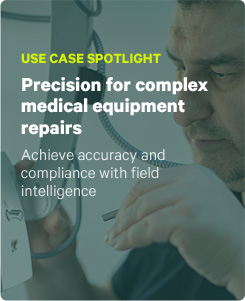At a glance:
- Prioritize user-centered design for technology rollouts.
- Listen closely to frontline workers to prevent workarounds.
- Treat technology as a tool to empower teams, not as a replacement for safety knowledge.
The daily pressures of field service leadership today are immense and can be complicated by factors like bad data and poorly designed field service safety workflows. It’s easy to overlook critical information when balancing efficiency, productivity, and cost control worker safety. However, in high-risk environments involving heavy equipment or oil and gas operations, lives depend on accurate, up-to-date data. Missing maintenance history, for example, could lead to equipment failure and endanger people. While field service remains one of the most hazardous occupations, a proactive approach to adopting data management technology can make a significant difference.
Taylor, EHS director at a mid-sized field service organization, wakes up abruptly at 5 AM. Glancing at the clock, he assumes he accidentally set his alarm too early. But as his phone continues its insistent buzzing, he realizes this isn’t a regular wake-up call. A phone ringing this much at this hour spells trouble for any safety officer. As he sits up, he sees a string of missed calls and increasingly frantic text messages.
The first voicemail comes from the company’s on-call emergency dispatcher. His voice is strained as he delivers the news: “Taylor, there’s been an accident on site. One of your guys is badly hurt.” Taylor’s heart races as he fumbles at his phone, his fingers shaking. Text messages from his operations manager, who is usually calm and collected, flash across the screen: “Call me NOW,” followed by “Heading to the hospital.” Taylor’s veteran technician, one of his most reliable team members, lies in a hospital bed with a badly broken leg. A portable generator, haphazardly secured on a makeshift shelf, tumbled down, crushing him. Taylor’s world is crumbling, and his frantic search for answers has only just begun.
Uncovering the hidden costs of insufficient data
As Taylor seeks answers, he turns his attention to the system’s job safety analyses (JSA) from recent months. At first glance, his technicians seem compliant – the weekly reports are all there. But how could this incident, which should have been preventable, still occur? The paperwork says this is an impossibility.
Pouring over the reports, he becomes increasingly uneasy. At first, everything looks normal, with some reports taking over an hour to complete with detailed notes to match. However, as he scrolls through more recent ones, he notices a troubling pattern. The completion timestamps are getting closer and closer together, with only seconds between some reports and just a few minutes between others. It’s barely enough time to even read the form properly. This raises a red flag in Taylor’s mind. Could this be a software glitch?
Taylor notices that these increasingly rushed reports coincide with the rollout of his new mobile workflow. Maybe it’s a coincidence? Too early to tell, but something tells him he needs to continue to get to the bottom of this puzzle. He moves on to the second part of his investigation, which involves interviewing staff members to determine the real cause of the issue. He needs to provide answers to his superiors and OSHA to ensure that this never happens again.
From field service safety workflow to safety hazard
In speaking with his team, Taylor identifies the culprit: duplicated JSAs. His new mobile workflow, which he designed to improve safety, was the very thing that ended up undermining it. The detailed worksite hazard assessment forms were so cumbersome that the technicians, under pressure to get jobs done, began finding workarounds.
What started as a minor shortcut to save time snowballed into disaster. Ironically, the veteran technician now lying in the hospital was the very same one who discovered that the company’s storage procedures hadn’t been updated to address the unique safety requirements of portable generators. Unfortunately, this crucial information never made it into the new system. The technology meant to protect lives had become a liability.
Taylor felt a surge of unease and a sense of mounting responsibility. This happened under his watch. He’d championed the new workflow, convinced it would improve safety. Now, a trusted member of his team was injured, potentially facing long-term complications. The company was facing a potential OSHA investigation for a fall protection hazard violation, and the fallout threatened his future with the company and his career as a safety leader. The potential lawsuit threatened the company’s reputation, and his team felt a sense of betrayal that he hadn’t foreseen the potential for this disaster. The most difficult thing to accept was that he could have foreseen these workarounds and prevented this disaster if he had genuinely prioritized user needs when designing the new field service safety workflows.
This incident is a stark example of technology deployment gone awry. In Taylor’s case, maladoption had taken hold – the techs missed the point of the workflow entirely because it wasn’t designed with their immediate needs in mind. If the forms had been more straightforward to use and genuinely helped them do their jobs better, they would have embraced the technology as a tool, not avoided it like the obstacle it was. Instead of empowering his team, Taylor’s well-intended efforts inadvertently set the stage for disaster.
From field service safety workflows to warning signs
Taylor’s experience highlights the dangers of implementing technology without considering the people who use it. It reminds us that intricate systems focused solely on technology can have severe consequences.
Ask yourself:
- Are your workflows designed with your frontline workers in mind? Do they make jobs more accessible and safer, or are they an added burden?
- Do you listen closely to your field technicians’ feedback and concerns? Their hands-on experience is invaluable for identifying potential safety risks.
- Do you view technology as a tool, not a cure-all? The most effective safety solutions combine the right technology with a focus on training and a strong safety culture.
While it’s too late for Taylor to change the past, it’s not too late for you. By working collaboratively with frontline teams and leveraging tools designed to integrate seamlessly with daily workflows, field service leaders can pave the way for safer, more efficient operations.




